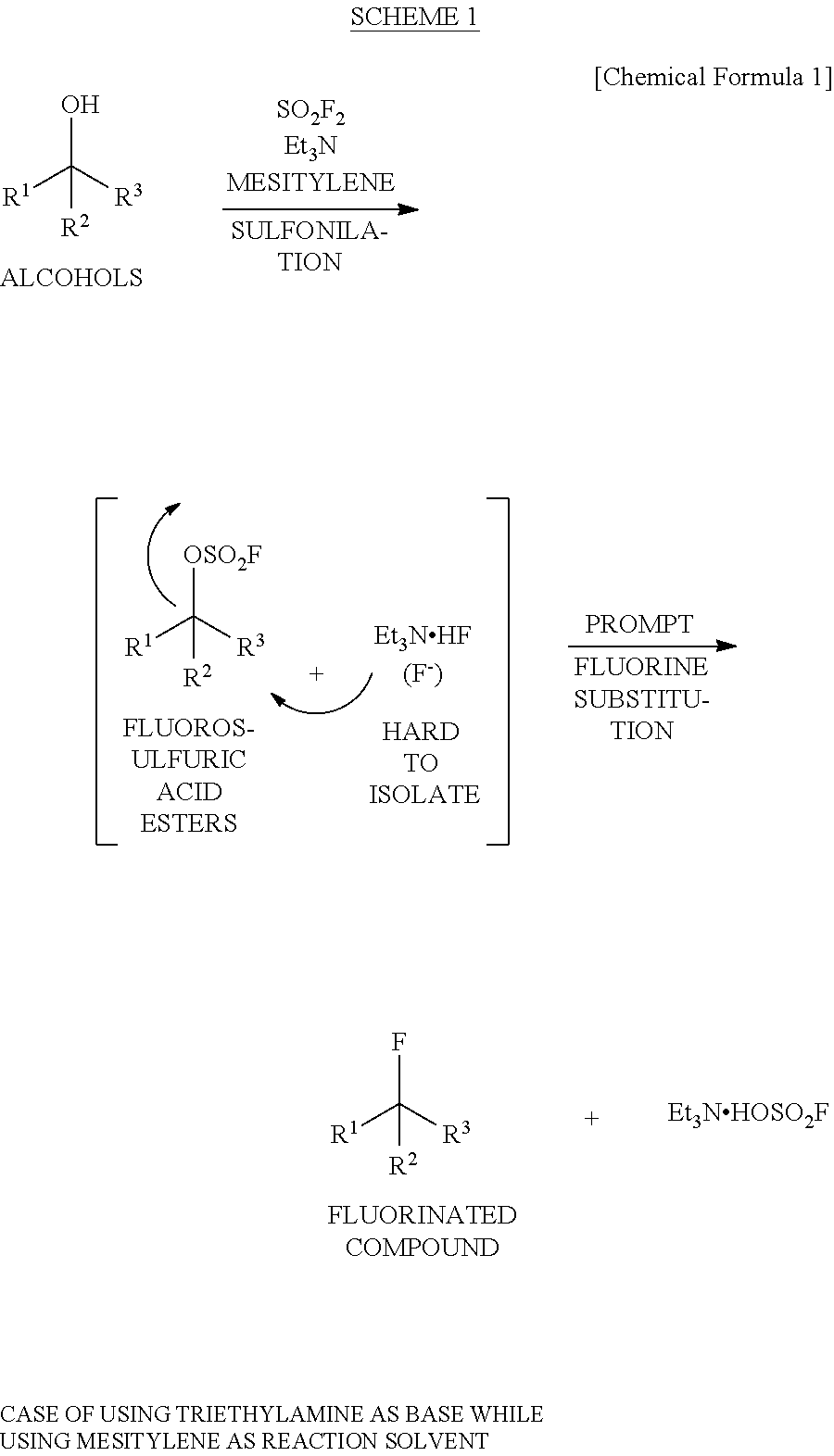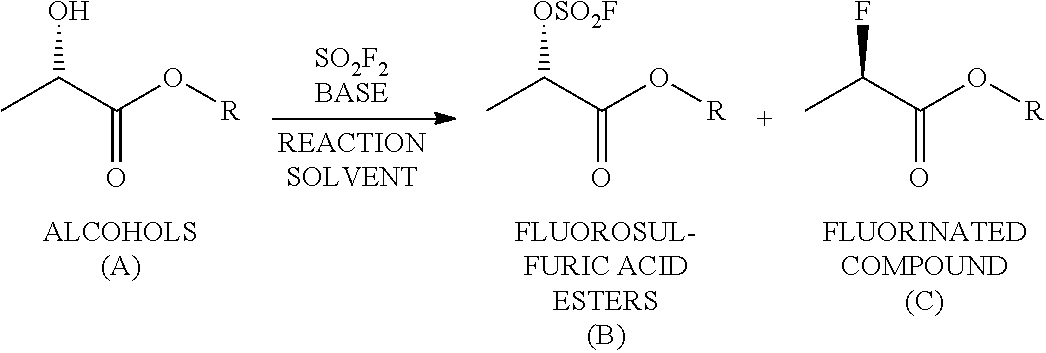Method for Producing Fluorosulfuric Acid Ester
- Summary
- Abstract
- Description
- Claims
- Application Information
AI Technical Summary
Benefits of technology
Problems solved by technology
Method used
Image
Examples
example 1
[0079]A pressure-resistant reaction container formed of stainless steel (SUS) was charged with 1.00 g (8.465 mmol, 1.00 eq) of an alcohol (having a racemic form) represented by the following formula
8.5 mL (1.00 M) of toluene, 1.03 g (10.179 mmol, 1.20 eq) of triethylamine and 8.5 mL (1.00 M) of water, followed by immersing the container in an iced bath. Then, 1.73 g (16.951 mmol, 2.00 eq) of sulfuryl fluoride was blown thereinto by using a bomb, followed by stirring it at room temperature all over the night. It was confirmed that the conversion ratio was 81% as a result of 1H-NMR analysis of a reaction-terminated liquid (an organic layer). It was confirmed from 1H-NMR analysis of the reaction-terminated liquid (the organic layer) that: the production ratio of the alcohol represented by the above formula was 19.4 while a fluorosulfuric acid ester (having a racemic form) represented by the following formula
was 80.6; and a fluorinated compound (having a racemic form) represented by the...
example 2
[0084]A pressure-resistant reaction container formed of stainless steel (SUS) was charged with 20.00 g (169.3 mmol, 1.00 eq) of an optically active alcohol (S configuration) represented by the following formula
141 mL (1.20 M) of toluene, 20.56 g (203.2 mmol, 1.20 eq) of triethylamine, and 176.10 g of an aqueous solution of potassium carbonate [the aqueous solution was prepared from 35.10 g (254.0 mmol, 1.50 eq) of potassium carbonate and 141 mL (1.20 M) of water], followed by immersing the container in an iced bath. Then, 34.56 g (338.6 mmol, 2.00 eq) of sulfuryl fluoride was blown thereinto by using a bomb, followed by stirring it under ice cooling for three and a half hours. It was confirmed that the conversion ratio was 96% as a result of gas chromatography analysis of a reaction-terminated liquid (an organic layer). At the time of measuring the conversion ratio, it was confirmed that the gas chromatography purity of an optically active fluorosulfuric acid ester (S configuration)...
example 3
[0089]A pressure-resistant reaction container formed of stainless steel (SUS) was charged with 20.0 g (81.5 mmol, 1.00 eq) of an optically active 4-hydroxyproline (2-position-S-configuration / 4-position-R-configuration) represented by the following formula
68 mL (1.20 M) of toluene, 9.90 g (97.8 mmol, 1.20 eq) of triethylamine, and 84.9 g of an aqueous solution of potassium carbonate [the aqueous solution was prepared from 16.9 g (122 mmol, 1.50 eq) of potassium carbonate and 68 mL (1.20 M) of water], followed by immersing the container in an iced bath. Then, 16.6 g (163 mmol, 2.00 eq) of sulfuryl fluoride was blown thereinto by using a bomb, followed by stirring it under ice cooling all over the night. As a result of liquid chromatography analysis of a reaction-terminated liquid (an organic layer), it was confirmed that the conversion ratio was 86%. In 19F-NMR analysis of the reaction-terminated liquid (the organic layer), an optically active fluorosulfuric acid ester (2-position-S-c...
PUM
| Property | Measurement | Unit |
|---|---|---|
| Optical activity | aaaaa | aaaaa |
Abstract
Description
Claims
Application Information
 Login to View More
Login to View More - R&D
- Intellectual Property
- Life Sciences
- Materials
- Tech Scout
- Unparalleled Data Quality
- Higher Quality Content
- 60% Fewer Hallucinations
Browse by: Latest US Patents, China's latest patents, Technical Efficacy Thesaurus, Application Domain, Technology Topic, Popular Technical Reports.
© 2025 PatSnap. All rights reserved.Legal|Privacy policy|Modern Slavery Act Transparency Statement|Sitemap|About US| Contact US: help@patsnap.com



